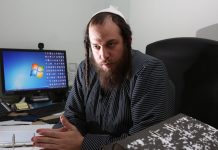Rabbi Meir Zlotowitz revolutionized the English-speaking Jewish world by opening the world of Torah learning for them. But how were the seeds of that revolution planted and nurtured?
In this fascinating excerpt from an upcoming ArtScroll biography of Rabbi Zlotowitz, by Yisroel Besser, that revolution is traced to his early days—and the inspiration
he received—in Camp Munk.
Happy laughter rose from the fields and courts dotting the sprawling grounds of Camp Munk, in Ferndale, New York. City boys who spent ten months a year in yeshivah luxuriated in the sunshine and relaxed schedule, discovering new talents and hobbies in the tranquil environment.
Meir Zlotowitz was no different. The camp’s founder, Rav Yechiel Aryeh HaKohen Munk, was a talmid of the Slabodka Yeshivah, an heir to the path of gadlus ha’adam transmitted by the Alter of Slabodka, Rav Nosson Tzvi Finkel: every person has a role, a singular mission, a means of becoming great.
Rabbi Munk looked at Meir Zlotowitz, not inclined to athletics, hampered by a severe stutter — and envisioned the glory that would yet come.
The boy was an artist: creative, innovative, and thorough.
And so Rabbi Munk gave him a job. In an alcove near the small head office in the main building, Meir Zlotowitz stood, pen in hand, and worked. With papers fanned out all around him, he took on one project after another: a beautiful bentching chart, then an attractive Eishes Chayil poster. Each week, the boys who had been awarded best in learning saw their names, written in calligraphy, mounted on the wall. There was scenery for the various plays and, of course, the banner for color war.
In camp, Meir Zlotowitz became a star.
Along with artistic flair, these jobs called for an appreciation for the messages he was meant to convey. He developed a depth in hashkafah, an ability to use images to express the eternity of Klal Yisrael, the centrality of Torah, the spiritual valor of a Jew. Rabbi Munk taught him how to use art, the significance of each letter and picture.
Rabbi Michel Chill, a friend from those camp days, remembers that it went beyond talent. Meir Zlotowitz exuded a special ruach, an elevated spirit. Even though he was young, he was looking for ways to contribute to Klal Yisrael.
In camp, Meir forged enduring friendships, broadening his own horizons — and he would also find a lifelong mentor.
Rav Dovid Cohen was a brilliant young talmid chacham, a talmid of Rav Yitzchok Hutner in Yeshivas Rabbeinu Chaim Berlin — and, as such, yet another heir to the chinuch approach of Slabodka. Rav Dovid knew Rav Ahron Zlotowitz, and he drew the rav’s personable teenage son close.
Rav Dovid appreciated Meir’s refreshing sense of humor and Meir, in turn, was taken by Rav Dovid’s sweeping knowledge of Torah, Jewish history, and Torah personalities. In their conversations, Meir discovered that everything had relevance; every idea, every ma’amar Chazal, each word used by a Rishon, was suffused with meaning.
An unofficial custom evolved over the summer of 1959: Meir Zlotowitz would join the newly married Rav Dovid and Rebbetzin Leah Cohen each day for lunch, sitting at their table in the camp dining room.
They seemed to enjoy his company, and he looked forward to these daily interactions.
Fifty-seven years later, Rabbi Zlotowitz — founder of ArtScroll/Mesorah Publications and architect of one of the greatest harbatzas Torah initiatives in recent history — called Rebbetzin Leah Cohen, wife of one of the most respected poskim in the world.
“I used to come eat lunch with you every day in Camp Munk,” he said, taking her back to a simpler, quieter time, “when you were in shanah rishonah, newly married. I didn’t realize it then, because you were so warm and welcoming, but it was wrong of me to intrude upon that private time. I just want to apologize.”
Rebbetzin Cohen laughed and assured Reb Meir that it was perfectly fine. She told him that they had enjoyed his company over that summer and were grateful for the beautiful relationship that had evolved. There was no reason to apologize, she said.
Six weeks later, Rabbi Zlotowitz passed away.
Many years earlier, Reb Meir had experienced a seminal chinuch moment with Rav Dovid. Reb Meir was visiting Camp Munk and Rav Dovid noticed that his young friend was wearing a stylish pair of burgundy pants.
Rav Dovid called him aside and put an arm around Meir’s shoulders. “Those are very nice pants,” he said, “but a ‘Meir Zlotowitz’ doesn’t wear burgundy pants!”
Reb Meir would repeat the story often. Well before the chinuch establishment preached the message, Rav Dovid had made him big, rather than small, had conveyed a message without a word of censure, had let him know who he was. Meir Zlotowitz had been touched by the glory of Slabodka.
Those summers in camp gave him exposure to the world of chinuch as well. In creating posters and materials for younger children, he learned how the right image or graphic could capture the imagination and communicate an idea.
Rabbi Yehoshua (Josh) Silbermintz was head counselor, and the perfect partner for Rabbi Munk. They understood that most of their campers were children of Holocaust survivors: these two mechanchim, Rabbi Munk and Rabbi Silbermintz, invested the campers with a sense that they were the answer, the ones who would rebuild that which lay in ruins.
While Rabbi Munk tended to the spiritual needs of his campers, his wife, Mrs. Miriam (Martha) Munk, a trained psychologist, ensured that each and every camper was receiving physical and emotional nourishment as well.2 Her ability to correctly diagnose the root of a problem gave the counselors tools of insight and understanding not readily available. It’s no surprise that many of the young men who summered in Camp Munk, influenced by Rabbi and Mrs. Munk, would become effective mechanchim and leaders.
In Camp Munk, there were children of roshei yeshivah and day-school boys—they were all cherished. On that summer day in 1957 when Rav Ahron Rokeach of Belz was niftar, Rabbi Munk addressed the campers. Too overcome with pain to speak, he wept instead, conveying the magnitude of the loss with his tears. There was one central message in that camp and it wasn’t about any party or affiliation: it was about Yiddishkeit, and the role of each individual Jew.
Tishah B’Av in Camp Munk was a special day. Rather than reason that there was little point in trying to make Kinnos meaningful, Rabbi Munk invested the few hours on Tishah B’Av morning with extraordinary significance. He would share memories of the Nazi atrocities he had witnessed, sharing painful personal recollections. He would then apportion the Kinnos between the various rabbanim and staff members, so that each Kinnah was given an introduction and context, presented in a way that was relevant and interesting to the boys.
Just a few years after the Holocaust, the boys of Camp Munk were being given the tools to understand the churban — and the task of rebuilding.
(More than a quarter-century later, ArtScroll would release its ground-breaking translation and commentary on the Kinnos. Camp Munk would be among the first to purchase the volume, ordering several cases and encouraging each and every staff member and camper to own a copy.)
Rabbi Munk had an original approach to color war. Rather than give the teams the standard names, like red and blue, he termed the activity “Hashkafah war” and gave each team a name to reflect an ideological path, like Beis Hillel and Beis Shammai, or Mekarvei Harechokim and Mechazkei Hama’aminim. It fell to the artist to transmit the potency and power of a position through the banner — and Meir Zlotowitz was made for the role.
Rabbi Munk had another remarkable idea. He harnessed the talents of his staff, and charged them to work together to construct a model of the Mishkan. It would call for exhaustive learning of the sources along with dexterity, patience, and artistic skill. As construction progressed, the campers became fluent in the halachos and the counselors learned to consult with leading talmidei chachamim — including Rav Yaakov Kamenetsky — regarding details of the Mishkan. When the Camp Munk Mishkan was completed, it was celebrated, taken to be shown at numerous yeshivos throughout the year.
In Camp Munk, Meir learned a new skill — art not just as a hobby, but as a means of chinuch.
Over the course of the following year, he would become active in writing and drawing for the Pirchei and Bnos leader guides, a handbook of ideas and inspiration for the teenage boys and girls who devoted their Shabbos afternoons to leading groups for children.
As his confidence grew, Meir began to articulate some of his dreams. He had a sheaf of papers that he guarded zealously, and spent hours working on. He showed it to his nephew and a few friends: it was an English translation of the Mishnah Berurah, a project he had undertaken in his spare time. In this private mission he had assigned himself, Meir Zlotowitz revealed some of what lay within his soul: not just a desperate drive to spread Torah, but a keen sense of where the future lay, an awareness that a new generation that spoke English was arising and could achieve clarity in Torah if it was presented in their language.
And it was there, in the peace and serenity of Camp Munk, that Meir Zlotowitz shared a secret dream, one he harbored deep in his heart. “One day,” he confided to a close friend, “I will translate all of Shas into English!”
Fittingly, in 1983 — before the ArtScroll Shas was published, but after the company had established itself as a leading disseminator of Torah — they released a book titled, The Wisdom of the Hebrew Alphabet; it was written by Rav Yechiel Aryeh HaKohen Munk:3 things had come full circle.
Years earlier, Rabbi Munk had seen Meir’s Mishnah Berurah notes and said, “You are very talented. You should continue writing.” Now, with that vision realized, Rabbi Meir Zlotowitz was honored to publish the sefer of the man who had believed in him early on. The book proved extremely popular, and after Rabbi Munk’s passing, Mrs. Martha Munk worked with Reb Meir to have it translated into Hebrew and published.
In a journal ad written a few years before his passing, Rabbi Meir paid tribute to the camp of his youth: Camp Munk instills a ruchniyus in each camper that carries him throughout the year and throughout his life. I am one of those campers. The feeling never leaves you.
The inspiration I absorbed spending summers in the makom Torah called Camp Munk, among gedolei Torah and chinuch, who honed my sensitivities and have remained close to me as guides all these years, is the impetus that motivates me daily.
When it came to writing skits and comedy routines in camp, Meir’s sense of humor was on full display. He embarked on an early publishing venture, a camp newspaper he titled Kol Meshugaim, a compendium of camp jokes and news.
A friend remembers a typical Meir joke — creative, teasing and original.
Meir was singing grammen in color war and, in the presence of Rabbi Munk, he poked gentle fun at the good-natured competition between two of the leading summer camps of the time, Camp Munk and Camp Agudah.
The color-war team names were Shamayim and Eretz, and Meir sang, “Eretz means earth, while heaven is shamayim,” then paused. He took a deep breath and sang, “L’shanah haba’ah…,” and as the audience anticipated the obvious ending, the word to rhyme with shamayim, Meir concluded, “L’shanah haba’ah b’Camp Agudah,” to delighted laughter from the crowd.
In fact, it would go beyond the joke. The next summer, Meir would join some of his yeshivah friends in Camp Agudah, where he was given the job of arts and crafts director.
If Rabbi Munk was the first great summertime influence in his life and Rav Dovid Cohen the second, then Rabbi Boruch Borchardt would be the third. The director of Camp Agudah would become a role model in achrayus, complete dedication to a cause.
Rabbi Borchardt, who had been born and raised in Germany, was a punctilious person. Working under him, Meir’s mischievous nature rose to the fore — and the camp director appreciated it.
Meir was shown his lodgings on the first day of summer, a decrepit room with peeling paint. He complained to the director that the room was ugly, and Rabbi Borchardt shrugged. “Feel free to paint it,” he said.
It was exactly the response Meir had been hoping for. Along with his two friends and roommates, Avie Gold and Mair Fogel, he headed to the hardware store in nearby Liberty to buy paint.
Rabbi Borchardt had expected them to purchase the standard brown paint, as in all the other rooms, but Meir came back to camp with cans of purple, yellow, and black paint, painting the doorframe one color, the walls another, and the windowsills a third.
Rabbi Borchardt smiled.
Before the following summer, Rabbi Borchardt asked the maintenance workers to paint the camp’s main building. They started the job, but quickly grew tired of the tedious task.
Meir, with his keen understanding of the artistic temperament, had the solution. He drove to Liberty and bought several gallons of paint in different colors. “Please do the moldings in a darker color and the doorways in a bright color,” he instructed the workers. Stimulated by the challenge, they got back to work.
One day, the campers were on a trip and there were no scheduled activities: Meir Zlotowitz had the afternoon off. He sat down at the top of the hill overlooking the camp, the landscape spread out in front of him, and, with a large easel before him, he started to paint. He spent the entire afternoon depicting the magnificent scene, the rolling hills and charming bunk-houses and mountains pressed against the clear blue sky in the distance. A beautiful picture emerged; onlookers marveled at the painting, but Meir Frischman recalls that the artist himself wasn’t impressed. Meir Zlotowitz took a marker and drew a large X across the painting. “It’s not perfect,” he shrugged in explanation.
Meir, along with his two roommates, grew very close to Rabbi Boruch and Mrs. Miriam Borchardt. In later years, Meir would often remember overhearing how Mrs. Borchardt complained to the camp cook when there was no coleslaw one Shabbos. “The boys need to enjoy Shabbos,” she protested.
“I would love to make coleslaw for them,” the cook countered, “but I don’t have time to check the cabbage for insects.”
“I’ll do it,” Mrs. Borchardt replied.
The camp director’s wife spent her summer Wednesdays standing by the window of her small bungalow checking cabbage — so that the boys should fully enjoy the Shabbos meals.
Meir would also recall how he and his friends had gone fishing in the lake near camp. The boys filled a bucket with fish, and then brought them to Rebbetzin Teitelbaum, wife of the camp’s rav, Rav Yaakov Teitelbaum. They asked her to cook the fish for them and the rebbetzin accommodated them, showing the boys how kosher fish are cleaned and prepared. Meir would often recall the dedication he had seen in camp, how no one was confined by the formal parameters of their job. These illustrious people all shared a common mission of giving the boys a happy, productive summer, and so they saw everything as a personal responsibility. The images — Mrs. Borchardt checking cabbage and Rebbetzin Teitelbaum cleaning fish — would remain with him, underscoring the lesson.
If, in yeshivah, Meir showed his serious, focused side, and camp revealed his fun-loving nature, it was at home that Meir developed the approach that would shape his own path to chinuch.
“It was a time when many parents, having endured so much pain and difficulty, had no idea how to express love for a child; Meir’s home was different. You felt his parents’ love for him as soon as you walked into the apartment; they would light up when they saw him. Even though money was tight, you had the sense that they would do whatever they could to make him happy,” recalls a childhood friend. “That wasn’t the norm then.”
A generation later, friends would notice that Reb Meir followed that approach with his own family; he never kept his love for his family under wraps.
Meir — who considered himself a lifelong talmid of his father — had a lot in common with Reb Ahron.
“They had the same eyes, the same ability to look right through you,” remarks a friend. “They were both able to gauge a person just by looking at him.”
There was the love of sefarim: teenage Meir had a large number of eclectic sefarim, and enjoyed helping his bar mitzvah-age nephews assemble their own collections. He was particularly proud that he owned every single sefer mentioned or quoted in the Mishnah Berurah.
Meir’s nephew, Meir Platnick, received a gift from his grandfather, a set of Aruch HaShulchan. Reb Ahron found a beautiful way to express his love for his grandson: He wrote a separate inscription inside the flyleaf of each volume, penning the berachos and words of encouragement again and again. This way, whichever volume of the sefer his grandson might use, the young man would remember his grandfather’s love.
In 1990, Reb Ahron Zlotowitz was niftar. Reb Meir sat shivah and, throughout the week, friends and family filed by and offered words of comfort, but Reb Meir didn’t cry. He sat stoically as he shared stories and memories, completely in control of his emotions. At one point, an old friend came in and sat there, listening quietly.
He looked at the avel and said five words.
“He loved you so much.”
Reb Meir listened and then burst into tears, crying for several minutes without speaking.
“Yes,” he finally said, “my father loved me so much.” l
Endnotes: 1. Interestingly, Meir’s father, Reb Ahron, was a talmid of Rav Yechiel Mordechai Gordon of Lomza. The Lomza rosh yeshivah was a talmid of Slabodka as well, and he had been especially close to the Alter, so at home too, Meir had absorbed this approach of seeing the greatness in each individual.
2. Camp Munk was established in 1949. When the buses pulled out of camp on the last day of that first season, Mrs. Munk sat down on a bench and began to cry, tears of relief that each and every boy had made it through the summer, healthy in body and soul.
3. Rabbi Nosson Scherman recalls that ArtScroll published the book as an expression of gratitude to the author, not anticipating that it would be a commercial success. In time, the book would become one of their most requested titles, reprinted several times.





















